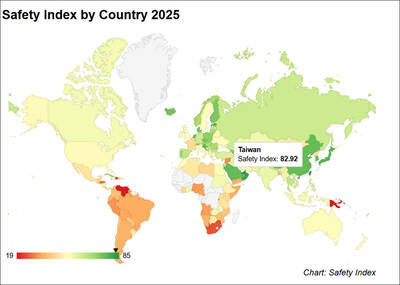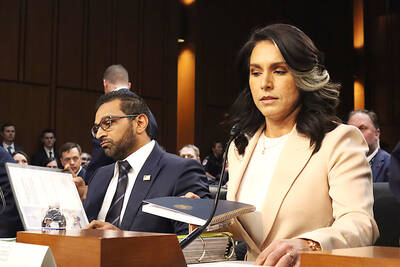The appearance of three cases in Taiwan of an acute form of pneumonia has implicitly exposed the country's isolation from the WHO.
When the three cases of what the WHO is calling "severe acute respiratory syndrome (SARS)" were reported last week, Twu Shiing-jer (
In the WHO's updated report about the SARS outbreak on Sunday, the organization called the disease "an atypical pneumonia of unknown etiology."
Taiwan's first two cases were reported to the Center for Disease Control (CDC) last Friday. The center reported the two cases to the WHO that day, it said.
The center also immediately reported the third case to the WHO after it was discovered on Saturday, it said.
The WHO issued an emergency travel warning regarding the disease on Sunday and an updated report on the outbreak yesterday.
However, when the WHO listed the countries from where it had received reports of SARS cases in its statements, Taiwan was conspicuously absent from the list.
Nevertheless, the center said it had done its best to keep the WHO up to date on the conditions of Taiwan's SARS cases.
Twu said that during his US visit he appealed for the WHO's help in investigating Taiwan's cases.
"The WHO is coordinating the international investigation of this outbreak and is working closely with health authorities in the affected countries to provide epidemiological, clinical and logistical support as required," the WHO's statement on Sunday said.
Although so far the organization has offered Taiwan no direct assistance, two officials from the US Centers for Disease Control and Prevention (USCDC) arrived at Taiwan on Sunday to join the investigation of the cause of the three cases.
On Sunday, Twu expressed disappointment that the WHO did not want to work with Taiwan.
But Chen Tsai-ching (陳再晉), director-general of Taiwan's CDC, said yesterday that the country needed to consider the WHO's dilemma in dealing with such diseases in a non-member state such as Taiwan.
"As long as the WHO has suggested the USCDC send officials to help us, we are very grateful," Chen said.
Hsieh Szu-min (謝思民), an infectious disease specialist from National Taiwan University Hospital, where the first two cases are in quarantine, said the WHO's help would be useful in determining how the two caught the disease.
"As SARS cases have been reported in many countries, transnational cooperation coordinated by the WHO would be more efficient to investigate the cause," Hsieh said.
But Hsieh said he expected a lot from the USCDC officials in examining the cases because "the center is very experienced in investigating unknown agents and viruses."
Hsieh said that over the past few decades, the center had accumulated considerable experience in studying outbreaks and their causes.
DPP lawmaker Lai Ching-te (
"As Taiwan is not a WHO member, it can't join other countries' investigation of SARS cases. It can't obtain first-hand information about the disease from the WHO, either," Lai said.
Taiwan cannot know how many SARS cases there are in other countries immediately, nor can it find out in which areas in the countries these cases were found, Lai said.
"We can't quickly know how these countries treat these cases. We don't know what health policies these countries adopt to contain the spread of the disease," Lai added.
Also See Stories:
Editorial: The Chinese virus invasion
Taiwanese steer clear of Hong Kong

AIR SUPPORT: The Ministry of National Defense thanked the US for the delivery, adding that it was an indicator of the White House’s commitment to the Taiwan Relations Act Deputy Minister of National Defense Po Horng-huei (柏鴻輝) and Representative to the US Alexander Yui on Friday attended a delivery ceremony for the first of Taiwan’s long-awaited 66 F-16C/D Block 70 jets at a Lockheed Martin Corp factory in Greenville, South Carolina. “We are so proud to be the global home of the F-16 and to support Taiwan’s air defense capabilities,” US Representative William Timmons wrote on X, alongside a photograph of Taiwanese and US officials at the event. The F-16C/D Block 70 jets Taiwan ordered have the same capabilities as aircraft that had been upgraded to F-16Vs. The batch of Lockheed Martin

GRIDLOCK: The National Fire Agency’s Special Search and Rescue team is on standby to travel to the countries to help out with the rescue effort A powerful earthquake rocked Myanmar and neighboring Thailand yesterday, killing at least three people in Bangkok and burying dozens when a high-rise building under construction collapsed. Footage shared on social media from Myanmar’s second-largest city showed widespread destruction, raising fears that many were trapped under the rubble or killed. The magnitude 7.7 earthquake, with an epicenter near Mandalay in Myanmar, struck at midday and was followed by a strong magnitude 6.4 aftershock. The extent of death, injury and destruction — especially in Myanmar, which is embroiled in a civil war and where information is tightly controlled at the best of times —

Taiwan was ranked the fourth-safest country in the world with a score of 82.9, trailing only Andorra, the United Arab Emirates and Qatar in Numbeo’s Safety Index by Country report. Taiwan’s score improved by 0.1 points compared with last year’s mid-year report, which had Taiwan fourth with a score of 82.8. However, both scores were lower than in last year’s first review, when Taiwan scored 83.3, and are a long way from when Taiwan was named the second-safest country in the world in 2021, scoring 84.8. Taiwan ranked higher than Singapore in ninth with a score of 77.4 and Japan in 10th with

SECURITY RISK: If there is a conflict between China and Taiwan, ‘there would likely be significant consequences to global economic and security interests,’ it said China remains the top military and cyber threat to the US and continues to make progress on capabilities to seize Taiwan, a report by US intelligence agencies said on Tuesday. The report provides an overview of the “collective insights” of top US intelligence agencies about the security threats to the US posed by foreign nations and criminal organizations. In its Annual Threat Assessment, the agencies divided threats facing the US into two broad categories, “nonstate transnational criminals and terrorists” and “major state actors,” with China, Russia, Iran and North Korea named. Of those countries, “China presents the most comprehensive and robust military threat